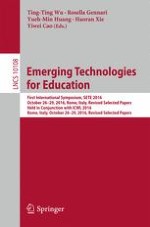2017 | OriginalPaper | Chapter
Closing the Reading Gap with Virtual Maze Environments
Authors : Lisa Gabel, Evelyn Johnson, Brett E. Shelton, Jui-Long Hung
Published in: Emerging Technologies for Education
Publisher: Springer International Publishing
Activate our intelligent search to find suitable subject content or patents.
Select sections of text to find matching patents with Artificial Intelligence. powered by
Select sections of text to find additional relevant content using AI-assisted search. powered by
